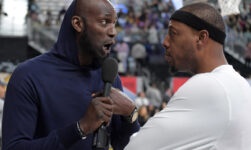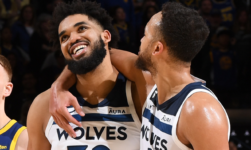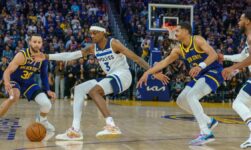Today’s guest columnist is Rick Burton of Syracuse University.
“This is cool.”
More from Sportico.com
“Oh my God.”
“What just happened?”
Those were only a handful of phrases I heard from my Syracuse sport management students the night of Feb. 27 while meeting at the school’s Bird Library to watch the Knicks-Celtics game via Xtadium’s immersive 180-degree virtual reality app. It was reportedly the first game ever presented in that format and a continuation of the NBA’s partnership agreements with Meta and YBVR.
“I’m so close.”
“Wild.”
“Awesome.”
For most basketball-loving North Americans, this late February game between two rivals was nothing more than a precursor to a possible playoff battle after the regular season ends April 9. For sports technologists and futurists, however, the game provided yet another milestone in the race to completely disrupt traditional broadcasting.
“Pretty impressive.”
“Oh wow.”
“I’m excited to see where this goes.”
The comments above may not seem like much, and admittedly my random sampling was small. These college age students (male, female, white, black, Latinx, Chinese, Thai) were not hand-picked. Just invited to check out what the NBA was doing in VR.
As they strapped on Quest 2 headsets, they were also given the chance to trial some NASCAR, UFC and EuroLeague Basketball (Real Madrid vs. Barcelona). Their reactions convinced me Generation Z is fully open to shifting, jolting or destroying the traditional flat screen paradigm.
That the NBA is ahead of the curve should not surprise anyone. Commissioner Adam Silver cut his teeth in NBA Entertainment and, like his predecessor, David Stern, who foresaw value in leveraging technology, marketing globally and establishing the WNBA (among too many other initiatives to list here), Silver is fully aware that technology’s tectonic plates are grinding. A professional sports earthquake is coming.
Story continues
I sensed the tremors during that Knicks-Celtics game when students started expressing how much more immersive the experience felt. The question for their midterm exam is this: How long until we reach the Gladwellian tipping point for VR?
The law (or theory) of diffusion of innovations, as referenced in one of Simon Sinek’s online videos (this one a Puget Sound TEDx Talk), states that for a new idea, product or service to secure mass adoption it must surpass the first 16% of humans willing to try something new.
These innovators (2.5%) and early adopters (13.5%) want to be first. More important, they influence the early and late majorities who deliver mass market success/acceptance.
When it comes to VR, the NBA and the rest of the pro sports world are not there yet. In fact, industry consensus seems to prefer telling anyone who asks that we are years away from most American households featuring Meta headsets.
But here’s an exam question for the industry’s cynics: If TV was a radio killer, is VR a TV killer? Radio never died, and neither will TV, but millennials have spoken with their streaming and cellular technology. Watching stationary, non-immersive TVs won’t work for Generation Alpha.
We’ve officially entered the transition of media. As evidence, consider this: Televisions came into experimental existence in the 1920s, but the first televised baseball game didn’t happen until 1939.
By 1955, 50% of American families owned a TV. In 1960, with set prices dropping, it reached 90%. Using rough math, it took less than 40 years from the earliest innovators to the point of mass acceptance.
With VR, tech historians will debate its formal arrival (most use the 1950s), but the first use of the words “virtual reality” didn’t really happen until the mid-1980s, or approximately 40 years ago. And the NBA was … wait for it … testing VR during Stern’s last season (2013-14). In ’14-15, the NBA was the first league to make virtual reality “experiences” possible, when it generated highlights of the NBA All-Star Game.
To kick off the 2015-16 season, with Silver at the controls, the NBA became the first league to broadcast a game in VR (partnering with Turner and NextVR). In 2020, the league officially partnered with Meta, and in January 2023, extended the multiyear deal, ensuring that fans with Quest headsets could enter Meta Horizon Worlds to see NBA and WNBA games.
“The hardware technology is not comfortable enough for consistent long viewing,” said Syracuse sophomore Stevie Chuck when asked about the NBA in VR, “but as the hardware and software improves, immersive viewing will become a much more viable option. This could be the future of portable viewing. Instead of teens pulling out their phones to stream games, I see them streaming an NBA game in VR. That is, when the hardware becomes more accessible/affordable. I think the NBA should continue to push the technology and ramp up the marketing around it.”
That’s just what the NBA is likely do—all while awaiting the arrival of Apple Glass, an augmented reality (AR) product, likely to launch no later than 2024 with some early versions possibly in test markets by this June.
While different from VR, the Apple glasses should be lightweight, cool-looking and possibly generate the same uptake as iPhones and iPads—part of an AR/VR market expected to reach $571 billion CAGR by 2025. If that happens, one should expect Major League Soccer, with its 10-year $2.5 billion Apple rights package, to start pushing the NBA for tech supremacy. MLS might even start thinking about world domination.
Rick Burton is the David B. Falk Professor of Sport Management at Syracuse University and former commissioner of Australia’s National Basketball League. He is the COO North America for Playbk Sports and his WWII novel, Into the Gorge, will be released by Amplify Publishing in June.
Best of Sportico.com
Click here to read the full article.






